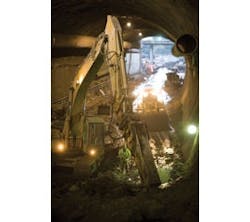2013 Top 10 Roads - No. 1
Project: Caldecott Fourth Bore
Location: San Francisco
Owner: Caltrans
Designers: Caltrans, Parsons Transportation Group, Jacobs Associates
Contractor: Tutor-Saliba Corp.
Cost: $390 million
Start Date: January 2010
Completion Date: June 2014
A bore with details
California tunnel project rises above all the complexity
They already knew too much, but the conversation did not end there. It just got louder and more intelligent.
Caltrans engineers wanted to be absolutely sure they knew what they were dealing with before—and during—the process of breaking up the hard underground of the Caldecott Fourth Bore tunnel project in the San Francisco Bay area. They had historical data from the first three tunnels showing the rock geometry and compiled plenty of current information through a series of cores. There also was the court order to keep noise at a minimum, as well as the stamp of approval needed from the first responders in the area—both at the federal and local level.
Everyone involved in this complicated burrow-birthing rose high above the call of duty, and in the end the project was above all else after it was named to the top spot of the 2013 Roads & Bridges Top 10 Roads list.
“I think we are very proud [of the No. 1 ranking], and I think we should be,” Ivy Morrison, public information officer for the Caldecott Fourth Bore, told Roads & Bridges. “We are very proud of our safety record. We are very proud of the fact that we are on schedule and on budget, and we are very proud of the partnerships behind the project.”
There was a point when the details matched the intensity of the task at hand. The Caldecott tunnels pass through three primary rock formations, all dating to the Miocene Period between 5 and 23 million years ago. The Orinda formation on the east side of the tunnel project is the younger rock and is less likely to fracture, but the Sobrante formation on the west side was the least stable of the three and required extensive support in the final 50 meters prior to the breakthrough of the boring process. Due to the difficult ground conditions the Sequential Excavation Tunneling Method was used.
“In hindsight, if we knew what we knew now, the design plans were probably too detailed in terms of ground classifications,” said Morrison. “The plans identified four main ground classifications and then subcategories, and this may not have been necessary.”
The current and final phase of the project also comes with layers of inspection and verification. The tunnel’s fire and life safety systems are currently being installed and must be integrated with each other as well as the legacy systems. They will then be tested and commissioned by the state fire marshal before functional testing is carried out, which culminates with a series of fire drills involving trained Caltrans tunnel inspectors and first responders. If everything checks out, the tunnel, which will function as a regional lifeline structure and must be able to reopen to emergency traffic within 72 hours following a major earthquake, should officially open to traffic by the end of 2013.
The Caldecott Fourth Bore’s fire-detection system consists of linear heat, carbon monoxide and nitrous oxide detectors, video-detection cameras and 19 jet fans. Upon detection of a fire this system will provide an automated ventilation response to support a safe evacuation.
At press time crews also were finishing up the installation of 990 stainless steel panels on the tunnel walls, which are made up of 1.6 million kg of steel rebar. Morrison said it is essentially a double layer of framework, and the concrete lining is thinner than most applications, about 12 in., for a reason: It’s expected to crack during an earthquake event, but the rebar will prevent any kind of collapse.
“If this tunnel was built in another part of the country you would not see this amount of rebar,” Morrison remarked.
Environmental lawsuits carry the same impact wherever you are in the U.S., and the Caldecott Fourth Bore was facing an important one before construction even got a firm foot in the ground. Noise concerns were raised from the city of Oakland and project neighbors as soon as the Environmental Impact Statement was released, and a court order called for the construction of a 30-ft-high, 11,000-ft-long temporary sound wall as well as constant noise monitoring. Nine sensors were installed, mostly on the Oakland (west) side, and data had to be posted on the project website daily. To date, Morrison said only a handful of complaints have been filed (mostly during excavation) and the project has not been shut down.
Opponents of the tunnel project also wanted a light-rail line to be considered, but it too would require a tunnel and “would not really solve the problem,” said Morrison. R&B
